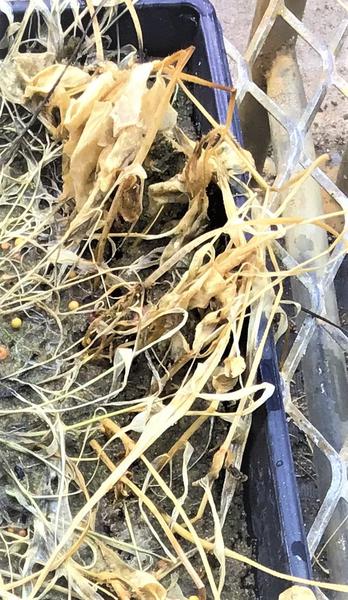Symptoms
Photosystem I-(herbicide group [HG] 22) II-inhibiting herbicides (HG 5) disrupt the photosynthesis process and encompasses many herbicides (e.g. atrazine, metribuzin, and paraquat).
Soybeans are very sensitive to atrazine. Atrazine (HG 5) applied pre- and postemergence is xylem mobile, which results in older leaves exhibiting injury while the new leaves appear healthy. Injury symptomology includes necrosis of the leaf margins, chlorosis and plant stunting. If atrazine persists in the soil at a high enough dose, soybeans may die before emergence. Labeled rotation and soil type-rate restrictions should be followed to avoid injury on soybeans following a crop where atrazine was applied.
Metribuzin affects plants in the same manner as atrazine. The injury caused by atrazine and metribuzin (HG 5) are often indistinguishable. However, metribuzin injury will likely only be evident on emerging soybeans as this herbicide is applied pre-emergence. Some soybean varieties are more sensitive to metribuzin; applied rates may have to be adjusted based on variety being planting. Soil type can also influence the level of metribuzin available to emerging plants which can cause injury to soybeans. Metribuzin will be more available in lighter (i.e. sandy) soils compared to heavier (i.e. loamy) soils. Metribuzin rates may have to be adjusted based on soil types.
Paraquat (HG 22) is a non-selective, contact herbicide. Injury symptomology includes necrosis where the spray droplet lands on the leaf. Low doses of paraquat will result in ‘peppered’ leaves where droplets landed, while high doses will result in necrosis of entire plant (plant death) (Figure 1). Injury and/or plant death from paraquat will occur within several hours of application.
Management
Labeled application and rotation restrictions should be followed to avoid atrazine carry over on soybeans. Metribuzin rates may need to be adjusted to avoid soybean injury if planting certain varieties or planting on certain soil types. Physical drift can be avoided by spraying when the average wind speed is less than 10 miles an hour and mid-day or –afternoon to avoid a temperature inversion.
Publication date: Jan. 11, 2021
N.C. Cooperative Extension prohibits discrimination and harassment regardless of age, color, disability, family and marital status, gender identity, national origin, political beliefs, race, religion, sex (including pregnancy), sexual orientation and veteran status.
NC Cooperative Extension prohíbe la discriminación por raza, color, nacionalidad, edad, sexo (incluyendo el embarazo), discapacidad, religión, orientación sexual, identidad de género, información genética, afiliación política, y estatus de veteran.
The use of brand names in this publication does not imply endorsement by NC State University or N.C. A&T State University of the products or services named nor discrimination against similar products or services not mentioned.
Recommendations for the use of agricultural chemicals are included in this publication as a convenience to the reader. The use of brand names and any mention or listing of commercial products or services in this publication does not imply endorsement by NC State University or N.C. A&T State University nor discrimination against similar products or services not mentioned. Individuals who use agricultural chemicals are responsible for ensuring that the intended use complies with current regulations and conforms to the product label. Be sure to obtain current information about usage regulations and examine a current product label before applying any chemical. For assistance, contact your local N.C. Cooperative Extension county center.
N.C. Cooperative Extension prohibits discrimination and harassment regardless of age, color, disability, family and marital status, gender identity, national origin, political beliefs, race, religion, sex (including pregnancy), sexual orientation and veteran status.

